Greece › Athens Travel Guide
Updated: December 9, 2025 • By Santorini Dave
Popular Pages
• Best Areas to Stay in Athens
• Best Hotels in Athens
• Best Hotels for Families in Athens
• Best Things to Do in Athens
• Acropolis Tickets
• Piraeus Ferry Port
• Athens to Mykonos Ferry
• Athens to Santorini Ferry
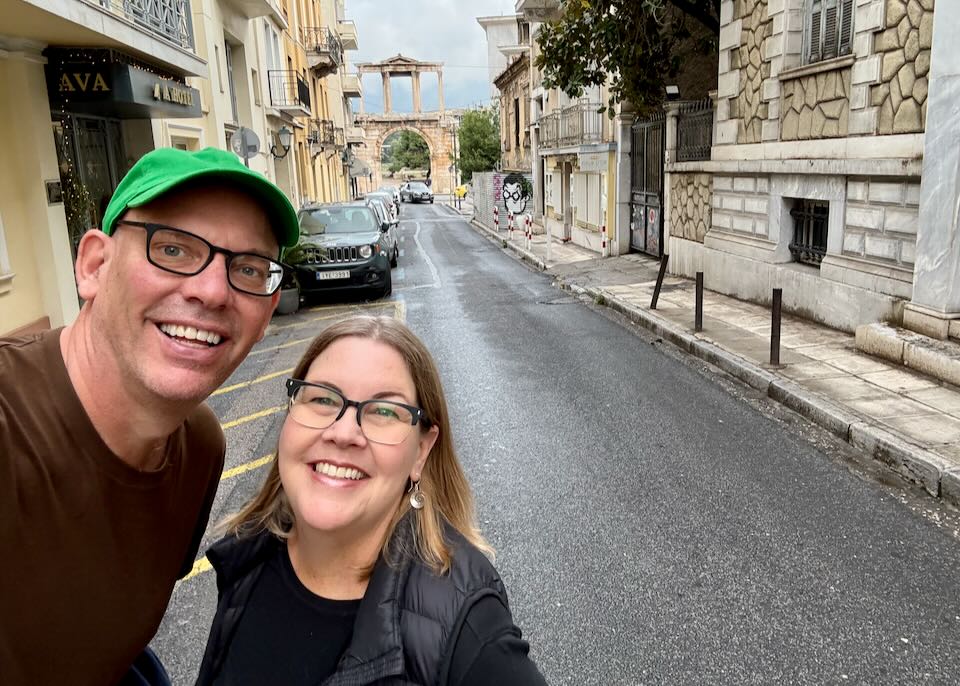
My wife and I in Athens, with the Arch of Hadrian in the background.
Athens, Greece’s capital city, is often used as a pit stop as travelers make their way to the marvelous Greek Islands and the country’s best beaches, but the sprawling city is packed with fantastic historical sites, world-class tours, luxury hotels, and great restaurants. When it’s time to move on, the city’s main ferry port is well connected by the Greek ferry system to Santorini, Mykonos, Naxos, Paros, Crete, and all of the islands of the Aegean Sea.
The 2026 Athens Travel Guide
- Skip to our Athens FAQ
Athens Basics
Athens Hotels
- Best Hotels in Athens
- Best Hotels on the Athens Riviera
- Best Hotels for Families
- Hotels with Acropolis Views
- Hotels with Rooftop Pools
- Good Value Hotels in Athens
- Athens Airport Hotels
- New Hotels in Athens
- Athens Hotel Map
Athens Activities and Attractions
- Best Tours & Things to Do in Athens
- Acropolis Tickets & Tours
- Best Museums
- Best Archaeological Sites
- Best Shopping
- Best Restaurants
- Best Bars and Clubs
- Athens Changing of the Guard
Athens Trip Planning
- Getting Around Athens
- Athens (Piraeus) Ferry Port Guide
- Airport Car Rental
- Athens to Delphi & Meteora
- Athens to Mykonos Ferry
- Mykonos to Athens Ferry
- Athens to Santorini Ferry
- Santorini to Athens Ferry
- Athens to Crete Ferry
- Crete to Athens Ferry
- Athens to Naxos Ferry
- Naxos to Athens Ferry
- Athens to Paros Ferry
- Paros to Athens Ferry
- Athens to Milos Ferry
- Milos to Athens Ferry
- Rafina to Mykonos Ferry
- Mykonos to Rafina Ferry
Latest Articles & My Travel Newsletter
Frequently Asked Questions about Athens
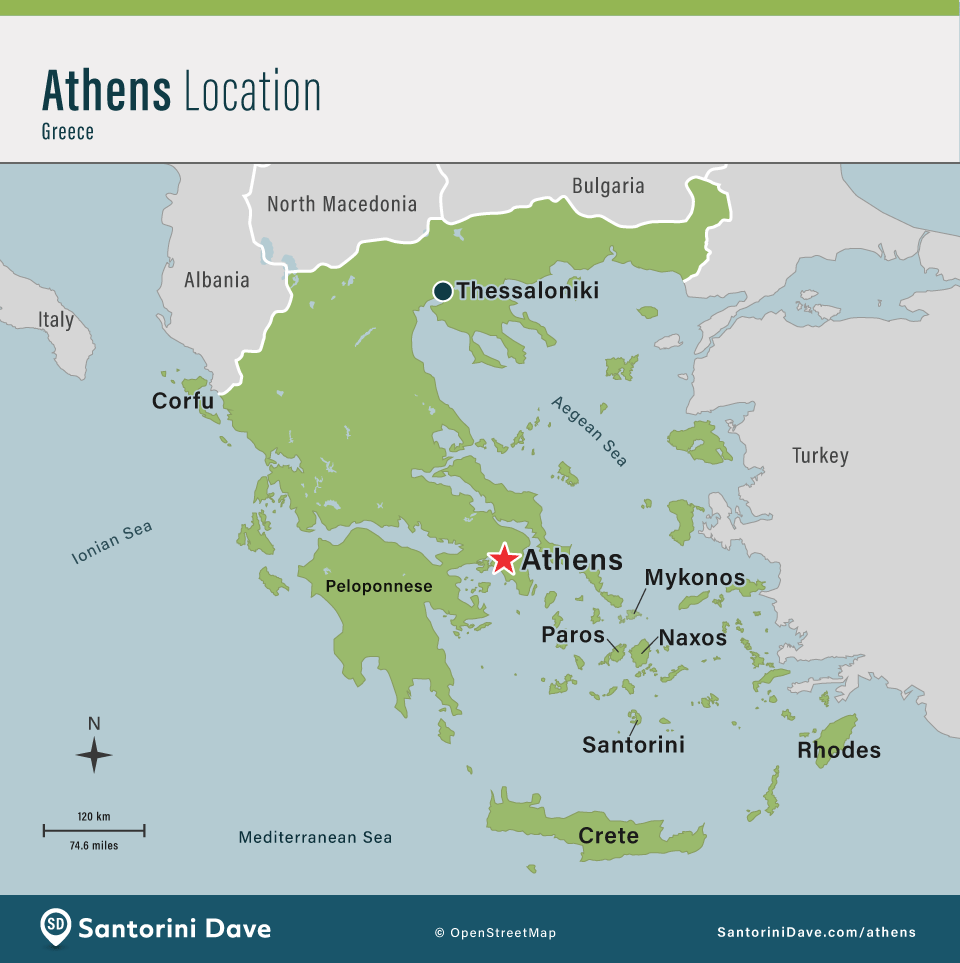
What is Athens famous for?
Athens is the historical capital of Europe, famous as the birthplace of democracy and the heart of Ancient Greek civilization.
- The Icons: Its skyline is dominated by the Acropolis and the Parthenon, the most important ancient monument in the Western world. Other major sites include the Ancient and Roman Agoras, the Temple of Olympian Zeus, and the all-marble Panathenaic Stadium.
- The Culture: Beyond the ruins, Athens is a vibrant, modern city known for its world-class museums (specifically the National Archaeological and Acropolis Museums) and its spirited nightlife.
- The Lifestyle: It is famous for its outdoor dining culture. One of the best things to do is simply wandering the pedestrian streets of Plaka and Monastiraki, enjoying excellent restaurants and the lively coffee scene.
Buying tickets in advance for the Acropolis is highly recommended.
What are the top 10 must-see attractions in Athens?
Athens is packed with history, but for a first-time visitor, these are the essentials.
1. The Acropolis (Parthenon)
The symbol of Western civilization. The complex includes the Parthenon, the Erechtheion (with the Caryatid porch), and the Temple of Athena Nike.
- Tip: You must book a specific time slot online in advance. The 8:00 AM slot is the only way to beat the crowds. Enter via the side entrance (near the Acropolis Museum) for shorter lines.
2. Acropolis Museum
Located at the foot of the hill, this stunning modern museum houses the original statues from the Parthenon. The top floor gallery mimics the temple’s orientation perfectly.
- Tip: Visit after the Acropolis to understand what you just saw. It has excellent air conditioning and a great restaurant with views.
3. Ancient Agora
The marketplace and political heart of ancient Athens. It contains the Temple of Hephaestus, which is the best-preserved ancient temple in Greece (even better than the Parthenon).
- Tip: Combine this with a walk through the Monastiraki Flea Market.
4. Plaka Neighborhood
The city’s oldest district. A maze of car-free, bougainvillea-draped alleys filled with neoclassical mansions, shops, and tavernas.
- Tip: Walk up to the tiny Anafiotika neighborhood (just above Plaka) for a hidden island-style village vibe right under the Acropolis cliffs.
A cold beer on a hot day in the Plaka.
5. National Archaeological Museum
The single most important collection of Greek antiquities in the world, including the gold Mask of Agamemnon and the Antikythera Mechanism.
- Tip: It is not near the Acropolis. Take a taxi, the Metro to Victoria station, or the #2 or #5 trolley bus from Syntagma Square. Allow at least 2 hours inside.
6. Panathenaic Stadium (Kallimarmaro)
The only stadium in the world built entirely of marble. It hosted the first modern Olympics in 1896.
- Tip: Climb to the top tier for an incredible photo of the stadium with the Acropolis in the background.
7. Temple of Olympian Zeus
Once the largest temple in Greece. Only 15 of the original 104 massive Corinthian columns remain standing, but the scale is awe-inspiring.
- Tip: It is a quick visit (30 mins). Combine it with Hadrian’s Arch right next door.
8. Roman Agora & Tower of the Winds
The commercial center during Roman times. The highlight is the Tower of the Winds, an octagonal marble clocktower considered the world’s first weather station.
- Tip: Located right in the heart of Plaka/Monastiraki. Easy to add to a walking tour.
9. Syntagma Square & Changing of the Guard
Watch the elite Evzones soldiers in their traditional uniforms guarding the Tomb of the Unknown Soldier in front of Parliament.
- Tip: The change happens every hour on the hour, 24/7. The “Grand Change” with the marching band is on Sundays at 11:00 AM.
10. Monastiraki Square & Flea Market
The energetic crossroads of the city. Famous for its flea market, rooftop bars, and street food.
- Tip: Visit the rooftop bar at A for Athens or 360 Degrees for a coffee or cocktail with the best eye-level view of the Acropolis in the city.
Bonus: Mount Lycabettus
For the best panoramic sunset view, take the funicular (or hike) to the top of this hill. You see the entire city, the Acropolis, and the sea all in one frame.
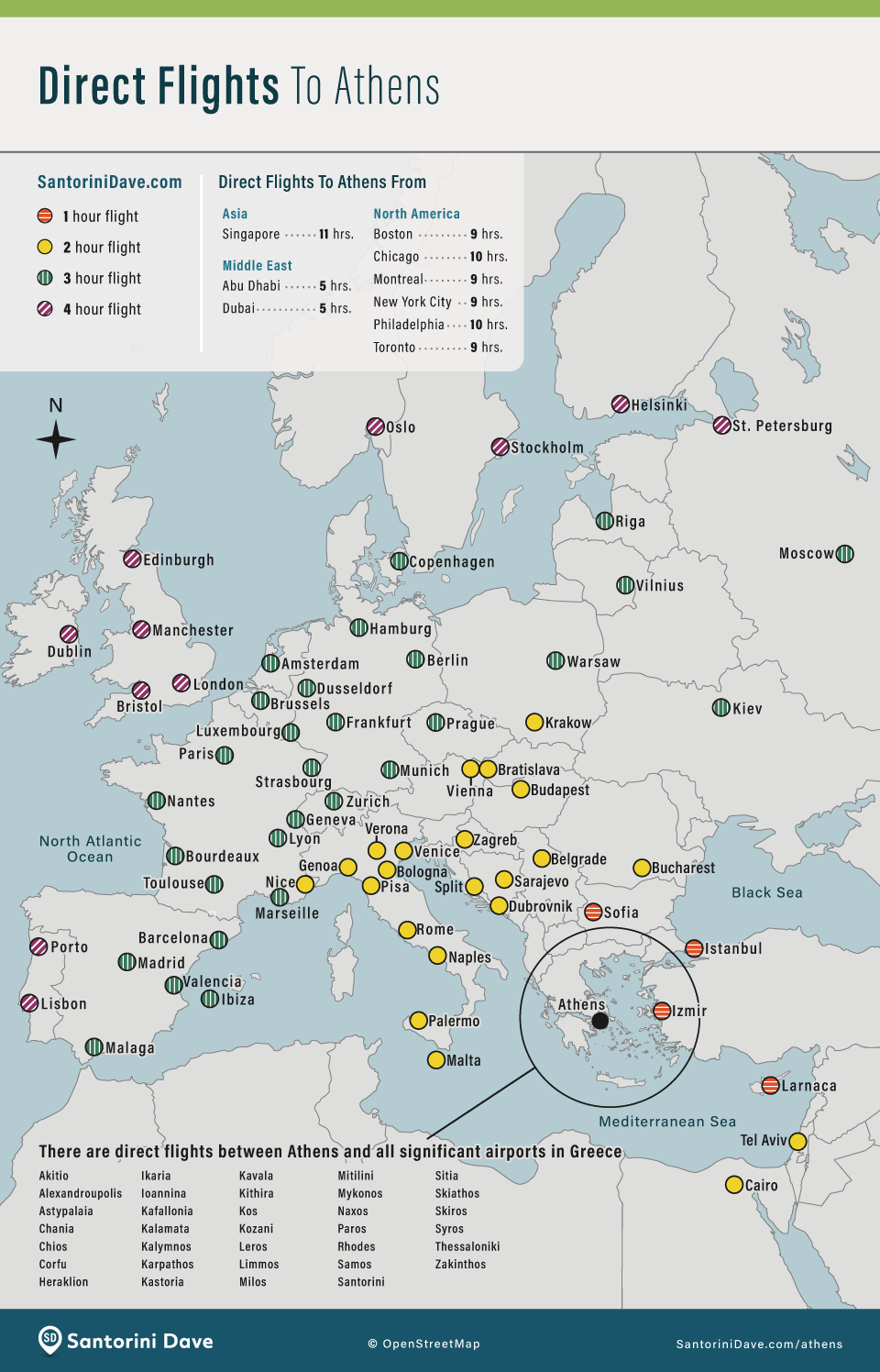
When is the Best Time to Visit Athens?
Athens is a year-round destination, but some months are significantly better for sightseeing.
- Best Time (Shoulder Season): April, May, June, September, and October. The weather is warm but manageable, and the city is lively without being overwhelming. You can sit outside at cafes comfortably day and night.
- High Season (July & August): It gets incredibly hot (often over 38°C/100°F).
- The Risk: In recent years, the Acropolis has occasionally closed during the hottest hours of the day (12:00 PM – 5:00 PM) to protect visitors. You must plan sightseeing for 8:00 AM.
- The Vibe: The city center is busy with tourists, but many locals leave for the islands, especially around August 15th. This means less traffic but some closed family-run shops. It is the perfect time to escape to the Athens Riviera beaches in the afternoon.
- Low Season (November to March): The best value. Hotel prices drop significantly. While it can rain, you often get crisp, sunny days perfect for hiking the Acropolis without the sweat.
- Bonus: Entry to archaeological sites (like the Acropolis) is free on the first Sunday of the month from November through March.
My Advice:
For the perfect balance of swim-worthy weather and comfortable sightseeing, aim for late May/early June or late September/early October.
Spring and fall are the best times to visit Athens, but most attractions (like the world-class Acropolis Museum) can be enjoyed year-round.
How Many Days Do I Need in Athens?
The short answer: Plan for 3 full days.
While you can rush through the highlights in a day, Athens is dense with history and culture. The logistics of visiting the Acropolis have changed significantly (mandatory time slots), which means you can no longer just “squeeze it in” without planning.
One Full Day (The “Express” Trip)
If you only have one day before catching a ferry, you must be strategic.
- The Priority: The Acropolis. You must book a specific time slot online in advance (I recommend the 8:00 AM slot to beat the heat).
- The Reality: After the Acropolis and the Acropolis Museum, you will have just enough time for a sunset dinner in Plaka. It is doable, but tiring.
Two to Three Days (The Sweet Spot)
This is the ideal amount of time for most first-time visitors.
- Why it works: You can see the “Big Three” (Acropolis, Ancient Agora, Acropolis Museum) without rushing.
- Neighborhoods: You have time to properly explore Plaka (historic charm), Monastiraki (markets and energy), and Psirri (nightlife).
- Logistics: Since the “Combo Ticket” was discontinued in 2025, having multiple days allows you to space out the entry fees and the walking.
Four Days or More (The “Deep Dive”)
Perfect if you want to move beyond the tourist trail.
- Local Vibes: Explore the cool, non-touristy neighborhoods of Koukaki (great brunch scene) or Kolonaki (upscale shopping).
- Day Trips: You have time for a half-day trip to the Temple of Poseidon at Cape Sounion (sunset is magic) or a full-day cruise to the car-free island of Hydra.
- Relaxation: Spend a day on the Athens Riviera to swim in the sea while still being just 30 minutes from the city center.
My Recommendation:
Aim for 3 full days. This gives you a buffer against jet lag and allows you to see the sites at a civilized pace. No matter how long you stay, I highly recommend taking a food tour on your first day – it is the best way to learn the city layout and get great restaurant tips for the rest of your trip.
What are the best neighborhoods to stay in Athens for first-time visitors?
Choosing the right neighborhood in Athens is the difference between a stressful trip and a magical one. You want to be in the “Historic Triangle” where you can walk to everything.
1. Plaka: The Dream Location
This is my favorite area of Athens. Nestled directly under the Acropolis, it’s a pedestrian-only maze of neoclassical mansions, bougainvillea, and sidewalk cafes.
- Pros: Unbeatable atmosphere. Steps from the Acropolis entrance, the Ancient Agora, and the Roman Agora. It feels incredibly safe and romantic at night.
- Cons: It is the most expensive area. In July and August, the main streets (like Adrianou) get packed with cruise ship crowds, though the side streets remain quiet.
- Best For: First-timers who want the classic, romantic Greek experience and don’t mind paying a premium.
2. Monastiraki: The Energy Hub
Located just next to Plaka, this is the buzzing commercial heart of the city. It centers around the famous Flea Market and Monastiraki Square. I enjoy it but it can be too busy for some.
- Pros: Incredible rooftop bars with eye-level views of the Acropolis. Unmatched transport links (direct Metro to both the Airport and Piraeus Port). Great street food and shopping.
- Cons: It is loud, chaotic, and gritty. On weekends, the crowds in the square can be overwhelming.
- Best For: Young travelers, solo travelers, and anyone prioritizing nightlife and easy ferry connections.
3. Syntagma: The Convenience King
The modern center of Athens, anchored by the Greek Parliament (and the Changing of the Guard) and luxury hotels like the Grande Bretagne (my favorite hotel in the city).
- Pros: The ultimate transport hub (Airport Bus and Metro meet here). It feels upscale, spacious, and safe. Easy walking distance to Plaka and the upscale shopping of Kolonaki.
- Cons: It lacks the “village” charm of Plaka. It feels like a busy European capital city with traffic and noise.
- Best For: Families who need easy stroller access (flatter streets), luxury travelers, and short stays where logistics matter most.
4. Koukaki: The Local Favorite
Located just south of the Acropolis, this neighborhood has transformed from a quiet residential area to the coolest spot in town.
- Pros: It feels like a real neighborhood, not a tourist set. The pedestrian streets (like Drakou) are lined with excellent brunch spots and modern tavernas that are better value than Plaka. It is steps from the Acropolis Museum.
- Cons: It is a 15-20 minute walk to the “center” of the action (Monastiraki/Syntagma).
- Best For: Foodies, repeat visitors, and those who want a “local” vibe while still being near the ruins.
Other Great Options
- Psirri: The nightlife district. Packed with artisan workshops by day and trendy bars/clubs by night. Stay here to party; avoid it if you want quiet.
- Kolonaki: The Beverly Hills of Athens. Upscale, safe, and full of designer boutiques. Be warned: it’s built on a steep hill, so expect lots of walking up steps.
- Thissio: The quietest central option. Wide, pedestrianized promenades with the best full-frontal views of the Acropolis. Great for families who want calm evenings.
My Recommendations:
- Choose Plaka if you want the “movie set” Athens experience and budget is flexible.
- Choose Monastiraki if you want energy, rooftop cocktails, and are catching an early ferry (the direct train to the port is quick and easy).
- Choose Koukaki if you want better food for less money and a slightly more authentic vibe.
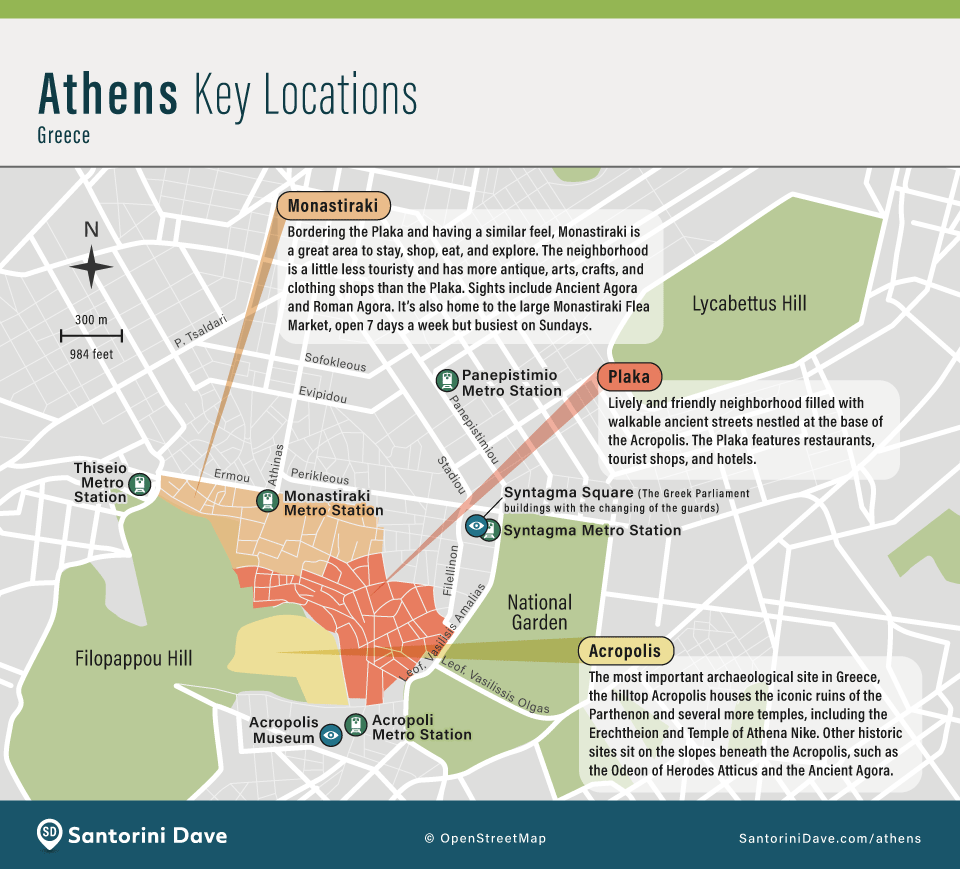
What are the best neighborhoods for nightlife?
Athens nightlife is legendary and diverse. The city doesn’t really sleep; it just takes a nap in the afternoon. The “best” spot depends entirely on your vibe. Personally, I’m fond of the cluster of alleys in Psirri.
- Psirri (The General Crowd Pleaser):
The Vibe: Trendy, energetic, and slightly gritty but safe. This is the current nightlife hub. It is packed with artisan cocktail bars, rooftop terraces, and tavernas playing western alternative or live rembetika (Greek blues) music.
The Crowd: A mix of tourists, young Athenians, and expats. It’s fun, accessible, and steps from Monastiraki.- Gazi (The Clubbers):
The Vibe: Industrial. Located around the old Gasworks. This is where the massive “super-clubs” and late-night dance venues are clustered.
The Crowd: Young, high-energy, and LGBTQ+ friendly (this is the center of gay nightlife in Athens). It gets going too late for me (after 1:00 AM).- Kolonaki (The Upscale/Posh):
The Vibe: Sophisticated and expensive. Think dress codes, premium spirits, and jazz bars.
The Crowd: Wealthy Athenians, older couples, and trendy tourists. If you want a sophisticated cocktail in a beautiful setting, go here.- Exarchia (The Alternative/Rock):
The Vibe: Edgy, bohemian, and political. This area is famous for its anarchist history. You’ll find rock bars, cheap beer, vinyl shops, and graffiti everywhere.
The Crowd: Students, artists, intellectuals, and alternative travelers. Safe but gritty.- Koukaki (The Local Chill):
The Vibe: Relaxed and hip. The pedestrian streets (like Drakou) are lined with wine bars and craft beer taprooms.
The Crowd: Locals in their 30s and 40s catching up after work. Great for a low-key night out.- Monastiraki (The Rooftops):
The Vibe: Touristy but spectacular. The squares are lined with hotels featuring rooftop bars (like A for Athens or 360 Degrees) that offer eye-level views of the illuminated Acropolis. Essential for at least one drink.Athens is packed with fun little bars like this one in Psirri.
What should I buy in Athens?
Athens is a fantastic shopping city. Skip the plastic fridge magnets and look for these high-quality local products.
- Handmade Leather Sandals:
Athens is famous for this. Head to the area near the Acropolis Museum for the famous Melissinos: The Poet Sandal Maker (currently at 16 Tzireon). For a variety of other workshops, explore the streets around Monastiraki.- Jewelry (Gold & Silver):
Greek jewelry design is world-class, often inspired by ancient Minoan or Byzantine patterns.
- High End: Visit the Voukourestiou Street area (near Syntagma) for famous Greek houses like Ilias Lalaounis and Zolotas.
- Mid-Range/Silver: The Plaka and Monastiraki areas are filled with independent jewelers selling beautiful handmade silver pieces.
- Olive Wood & Ceramics:
I bought a tavli board (backgammon) in Plaka and it held up well. Olive wood bowls, cutting boards, and utensils are durable and beautiful. For ceramics, look for hand-painted pottery (copies of ancient museum pieces or modern designs). Tip: Check the bottom of the piece to ensure it says “Made in Greece” and not an import.- Natural Cosmetics:
Greek brands like Korres and Apivita are famous for using Greek herbs, honey, and olive oil. You can find them in any pharmacy (look for the green cross) at better prices than at home.- Food Products (The Edible Souvenirs):
Go to a high-quality deli (like Pantopoleion near Monastiraki) to buy:
- Greek Honey: Thyme honey from Crete is my favorite.
- Mastiha: A unique resin from Chios used in liqueurs and cosmetics.
- Saffron (Krokos Kozanis): I’m no saffron expert but supposedly this is some of the world’s best.
- Herbs: Dried wild oregano and mountain tea.
The view of the Acropolis from the rooftop pool at The Dolli.
Are there good hotels with Acropolis views?
Yes, absolutely. Waking up or enjoying a drink with a direct view of the Parthenon is a bucket-list experience.
My favorite hotels with Acropolis views are clustered in the “Historic Triangle” (Plaka, Monastiraki, Syntagma) and the Koukaki neighborhood.
My Recommendation:
For a special occasion, splurge on a view room at The Dolli or Grande Bretagne. For a great balance of value and views, book a standard room at Electra Metropolis or Herodion and spend your evenings on their spectacular rooftops.Omilos Restaurant (one of our favorites) in Hydra.
What are the best Greek Islands near Athens?
You don’t need to fly to Santorini to get a Greek island experience. The Saronic Islands are just a short ferry ride from Piraeus, perfect for a day trip. For a taste of the Cyclades without the crowds, Kea and Kythnos are hidden gems near the Lavrio port.
The Saronic Islands (Departs from Piraeus)
These are the easiest escapes. Ferries run frequently from Piraeus Gates E8 and E9.
- Hydra (The Classiest Escape)
- Vibe: Sophisticated, artistic, and completely car-free. Transport is by donkey, water taxi, or foot. It has a stunning, amphitheater-shaped harbor lined with 18th-century stone mansions.
- Best For: Couples, walkers, and Leonard Cohen fans.
- Travel Time: 1.5 to 2 hours by high-speed ferry (Aero or Flying Cat).
- Verdict: Doable as a day trip, but staying overnight allows you to experience the magical, quiet evenings.
- Aegina (The Quickest Fix)
- Vibe: A bustling, authentic working island famous for its pistachios. It feels like a suburb of Athens but with island charm.
- Highlights: The incredible ancient Temple of Aphaia and the seaside village of Perdika.
- Travel Time: 40 minutes (Hydrofoil/Aero) to 75 minutes (Ferry).
- Verdict: The #1 choice for a quick, easy day trip.
- Agistri (Turquoise Waters)
- Vibe: Tiny, green, and relaxed. It is less about “sights” and all about swimming in crystal-clear water pine-fringed coves.
- Highlights: Swimming at the rocky Chalikiada beach (naturist-friendly) or the flat rocks of Dragonera.
- Travel Time: 55 minutes by high-speed ferry.
- Verdict: The best island for a “pure swimming” day trip.
- Poros (The Scenic Channel)
- Vibe: Lush and green. The main town is separated from the Peloponnese mainland by a tiny channel, creating a unique “river-like” feel.
- Travel Time: 1 hour (High-speed).
- Verdict: A relaxed, easy day trip with great views from the clock tower.
- Spetses (Aristocratic Elegance)
- Vibe: Posh and historic. Known for its horse-drawn carriages, grand captains’ mansions, and boutique shopping.
- Travel Time: 2.5 hours.
- Verdict: A bit far for a day trip. Better for a glamorous weekend stay.
The Nearby Cyclades (Departs from Lavrio)
If you want the classic “white sugar-cube house” look, you need the Cyclades. These two islands are close to Athens but require leaving from the smaller port of Lavrio (near the airport).
- Kea (Tzia): A hiker’s paradise with a unique architectural style (earth-toned stone, not white). It has a sophisticated, “in-the-know” Athenian vibe.
- Travel Time: 1 hour from Lavrio.
- Kythnos: The most “traditional” Cycladic island near Athens. It has whitewashed villages (Chora and Driopida), thermal springs, and the famous double-sided Kolona Beach.
- Travel Time: About 1.5 hours from Lavrio. (Also reachable from Piraeus in summer, but less frequent).
My Recommendations
- For History & Style: Go to Hydra. It is unlike anywhere else.
- For Swimming: Go to Agistri. Rent a bike and find a cove.
- For a Quick Daytrip: Go to Aegina. See the temple, eat pistachios, and be back in Athens for dinner.
Athens is generally safe and well-lit at night. The safest areas for travelers to stay are Monastiraki and Plaka.
Is Athens safe?
Athens is a little rough around the edges in spots, but it is a safe destination with a very low violent crime rate. Much of Athens is pedestrianized and well-lit, and there are usually plenty of people about. Your main focus should be on preventing petty theft like pickpocketing, especially in crowded areas such as the Metro (airport/port lines), Monastiraki market, and Syntagma Square. While main tourist neighborhoods like Plaka and Monastiraki are safe day and night, exercise more caution if walking alone very late in areas further out, like around Omonia Square. Athens is considered safe for solo female travelers practicing standard big-city awareness.
Is Athens a walkable city for tourists?
Yes, Athens is incredibly walkable. For the vast majority of historic must-sees, walking is not just possible – it is my favorite way to experience the city.
The Walkable Core
The “Historic Triangle” where you will spend most of your time is surprisingly compact. You can easily walk between the following major hubs in 15-20 minutes:
- Plaka & Anafiotika: The charming old town nestled under the Acropolis.
- Monastiraki: The bustling market area with ancient ruins like Hadrian’s Library.
- Syntagma: The modern center and home to Parliament.
- The Acropolis Promenade: The grand pedestrian walkway (Dionysiou Areopagitou) that connects the Acropolis Museum, the Odeon of Herodes Atticus, and Thissio. It is one of the most beautiful walks in Europe.
Things to Keep in Mind
- Hills & Marble: Athens is hilly. Be prepared for slopes and steps, especially in Plaka. The marble pavements can be slippery, even when dry. Comfortable, non-slip shoes are non-negotiable.
- Summer Heat: In July and August, walking in the midday sun (12pm–4pm) is grueling. Plan your walks for early morning or late evening.
The metro from Monastiraki to Piraeus. The best way to get to the ferry port from downtown.
What are the best transportation options for getting around Athens?
Navigating Athens is straightforward. The public transport system is modern, safe, and integrated.
1. The Metro (Fast & Efficient)
This is the best way to move between key hubs if you get tired of walking.
- Line 1 (Green): Connects Monastiraki to Piraeus Port.
- Line 2 (Red): Connects Syntagma to the Acropolis Museum.
- Line 3 (Blue): The “Airport Line.” Connects the Airport to Syntagma, Monastiraki, and Piraeus Port.
- Operating Hours: 5:30 AM to Midnight (open until 2:00 AM on Fridays/Saturdays).
2. Paying for Public Transport (Contactless Payment)
You no longer need to buy paper tickets from a machine if you don’t want to.
- Tap & Go: You can simply tap your contactless credit card or phone (Apple Pay or Google Pay) directly on the turnstile or bus validator.
- Standard Fare: €1.20 (valid for 90 minutes of transfers).
- Daily Cap: The system automatically caps your charge at €4.10 per day, no matter how many rides you take.
- Paper Tickets: Still available at machines if you prefer cash.
- 5-Day Ticket: €8.10 (Great value for longer stays).
- 3-Day Tourist Ticket: €20 (Includes round-trip airport transport).
3. Airport Transport (Special Rules)
Standard €1.20 tickets DO NOT work for the airport. You must buy a specific ticket.
- Metro: €9 one-way. Takes 40 mins to center.
- Express Bus (X95 to Syntagma): €5.50. Runs 24/7. Takes 60 mins.
4. Taxis & Uber
- Uber: Uber operates in Athens, but it is “Uber Taxi.” You hail a licensed yellow taxi through the app. It’s reliable and safe, and what I use in Athens when I need a ride.
- FreeNow: Another popular taxi-hailing app that works similar to Uber.
- Lyft: Does not operate in Greece.
- Airport Flat Rate: Taxis from the Airport to the City Center have a fixed legal price: €40 (Day: 5am–Midnight) and €55 (Night: Midnight–5am).
My Recommendation:
Walk as much as you can – it is the joy of Athens. Use the Metro to get to the National Archaeological Museum or Port. Use Uber or a pre-booked transfer like Welcome Pickups for airport trips if you have heavy luggage.The Piraeus ferry port serves multiple daily ferry routes to most of the Greek Islands, like this catamaran heading to Hydra.
Which Athens Port should I use?
- Piraeus (The Main Port): This is where 90% of travelers should start. It serves almost every island, including the Cyclades (Santorini, Mykonos, Paros, Naxos), Crete, and the Saronic islands.
Getting there: Easily reached from central Athens via Metro Line 1 (Green) or Line 3 (Blue). If coming from the Airport, take the Line 3 straight to the port (no transfers needed).- Rafina (The Airport Port): Located on the east coast, only 30 minutes from Athens Airport.
Best for: Travelers landing at the airport who want to head straight to the Northern Cyclades (Andros, Tinos, Mykonos) without going into downtown Athens. It also has daily connections to Paros and Naxos, though Piraeus has more frequent options.- Lavrio (The Southern Port): Located near Cape Sounion. It is the main hub for Kea and Kythnos, and also serves the remote island of Lemnos. It is not used for the popular tourist islands like Santorini or Mykonos.
There are daily direct ferries from Athens to Santorini, Athens to Mykonos, Athens to Crete, Athens to Naxos, Athens to Paros, and Athens to Milos. For other ferry routes check Ferryhopper.com.
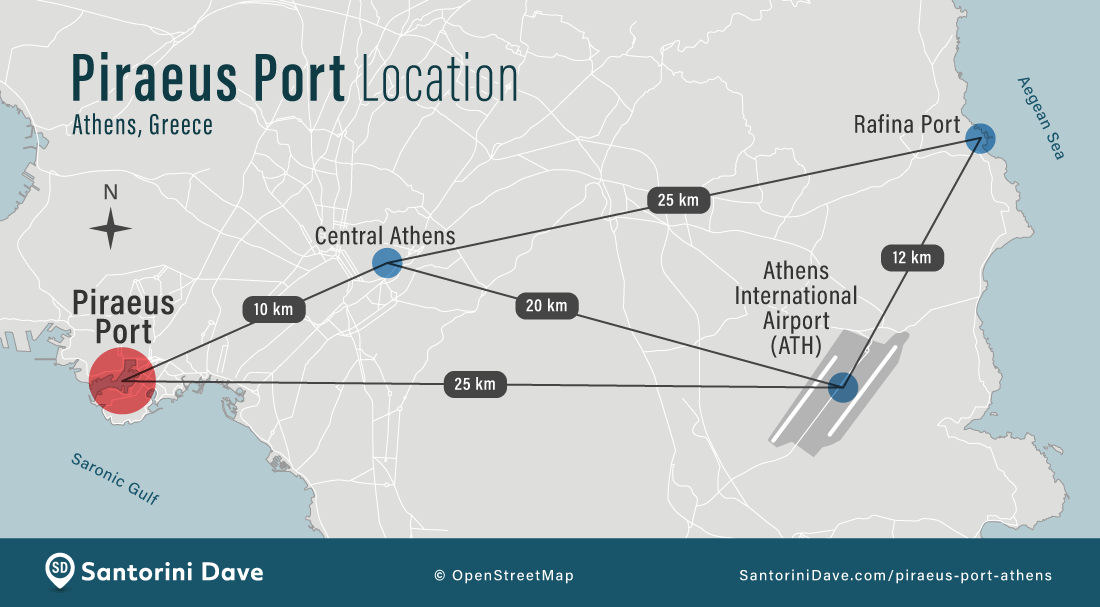
Is Athens Expensive? What’s a Typical Daily Budget?
Compared to London or Paris, Athens is affordable, but costs have risen significantly in the last two years. It is no longer a “cheap” destination, especially regarding accommodation and entry fees.
Here is a realistic idea of 2026 costs:
- Accommodation: Hostels range from €35-€50. A decent mid-range hotel in Plaka or Monastiraki is now €120-€200+ per night. Luxury hotels with Acropolis views start at €350 and go well over €1,000 in high season.
- Food: You can still eat well for less. A pita gyro (souvlaki) now costs €3.50 to €4.50 (up from €2.50 a few years ago). A sit-down dinner at a taverna is about €20-€35 per person with house wine. Fine dining is €80+ per person.
- Attractions (Major Changes):
- The Acropolis: The ticket is now €30 year-round. (The old low-season discount and “Combo Ticket” have been discontinued).
- Acropolis Museum: €15 (Summer) / €10 (Winter).
- National Archaeological Museum: €12 (until end of 2025), rising to €20 in 2026.
- Transport: The Metro remains a bargain at €1.20 (valid for 90 mins). Taxis are reasonable for short hops (€5-€10 in the center), but Airport transfers are fixed at €40 (Day) and €55 (Night).
Daily Budget Estimates (Per Person):
- Budget Traveler (€80-€100): Hostels, street food (gyros/pies), walking everywhere, selective museums.
- Mid-range Traveler (€200-€300): Boutique hotel (shared room), one sit-down meal a day, ferry trips, and all major sites.
- Luxury Traveler (€500+): 5-star hotel, private transfers, tasting menus, and guided private tours.
Key Tip: Athens offers incredible value in its bakeries. You can get a fresh spinach pie (spanakopita) or cheese pie (tiropita) for €2.50, which makes for a delicious and filling lunch.
Taking a tour is a great way to maximize your time in Athens. The Athens Gourmet Food Tour is an excellent introduction to the city.
What Currency is Used? Do I Need Cash?
Greece uses the Euro (€).
- Credit Cards (Tap-to-Pay): Visa and Mastercard are accepted almost everywhere, including taxis, kiosks (peripteros), and Metro stations. You can pay for a €2 coffee with your card. American Express is less common outside luxury venues.
- Cash is Still King for:
- Tips: Staff always prefer cash tips.
- Small Islands/Villages: If you take a day trip to Agistri or explore a tiny village, cash ensures you won’t be stuck if a card machine “breaks.”
- Small Discounts: occasionally, small shops may offer a better price for cash.
- ATMs:
- Use: ATMs attached to actual banks (Piraeus, Alpha, National Bank, Eurobank).
- Avoid: The blue/yellow standalone “Euronet” ATMs found in tourist centers. They charge massive fees.
Crucial Payment Tip: The “DCC” Trap
When you pay with a card or use an ATM, the machine will ask: “Pay in Euros or [Your Home Currency]?”
ALWAYS CHOOSE EUROS.
If you choose your home currency, the machine uses “Dynamic Currency Conversion” (DCC) to apply a terrible exchange rate with hidden fees. It can cost you an extra 5-10% on every transaction. Let your home bank handle the conversion.What Electrical Adapter Do I Need?
Greece uses the standard European electrical system:
- Voltage: 230 Volts (50 Hz)
- Plug Type: Type F (Schuko) and Type C (Europlug). They have two round pins.
For Travelers from the US & Canada
Your outlets run on 110V. Greece runs on 230V. You need to know the difference between an Adapter and a Converter.
- The Adapter: You always need this. It is the simple plastic piece that changes the shape of your plug to fit the wall (Type C/F).
- The Converter: You usually do not need this for modern electronics (iPhones, MacBooks, Kindles, Camera chargers). Look at the fine print on your device’s power brick. If it says
INPUT: 100-240V, it is dual voltage and safe to use with just a plug adapter.- The Hair Dryer Warning: Do not bring your American hair dryer, curling iron, or straightener unless it has a specific, manual “Dual Voltage” switch. Even with a heavy-duty converter, these high-wattage appliances often overheat, melt, or blow the hotel’s fuse. Use the hotel’s hair dryer or buy a cheap one locally.
For UK, Ireland, Australia & NZ
- You only need a plug adapter. Your devices operate on the same 230V voltage as Greece, so you do not need a voltage converter.
- UK/Ireland: You need a Type G to Type F adapter.
- Australia/NZ: You need a Type I to Type F adapter.
My Recommendation:
Buy a Universal Travel Adapter that includes multiple USB/USB-C ports. Hotel rooms in Greece often have limited outlets (sometimes just one free one), so being able to charge two phones and a watch from a single wall socket is a huge convenience.Most of the best restaurants in Athens, like Pame Tsipouro Pame Kafeneio in Monastiraki, accept credit cards.
What are the best beaches near Athens?
Athens has a surprisingly fantastic coastline known as the Athens Riviera. It stretches south from the city center to Cape Sounion.
Important 2026 Update: The Ellinikon Project
A massive urban regeneration project (The Ellinikon) is under construction between Alimos and Glyfada (the old airport site). While the beaches remain open, be aware that the area around Agios Kosmas is currently a major construction zone. For a relaxing day, I recommend heading further south to Voula, Vouliagmeni, or Varkiza to escape the cranes and dust.Getting to the Beaches
- Tram (Scenic but Slow):
- Line T7 (Piraeus to Voula): Stops at all major coastal spots (Faliro, Alimos, Glyfada, Voula).
- Line T6 (Syntagma to Pikrodafni): Connects the city center to the coast, where you transfer to the T7.
- Bus (Faster):
- A2 (Syntagma to Voula): Good for getting to the southern suburbs.
- 122 (Elliniko Metro to Varkiza): The best “beach express” hack. Take the Metro (Red Line 2) to the end (Elliniko station), then hop on the 122 bus. It takes you past the traffic to Vouliagmeni and Varkiza.
- Taxi/Uber: Cost is €15–€25 to the near beaches (Alimos/Glyfada) and €30–€40 to Vouliagmeni.
The Best Organized Beaches (Closest to Athens)
- Alimos (Akti tou Iliou): The closest “real” beach club to the center. It has waterslides, beach bars (Bolivar), and loud music. Good for parties, less for relaxation.
Cost: €8–€10 entry + €5–€10 per sunbed.- Voula (A’ Plaz & B’ Plaz): Excellent sandy beaches with shallow water, ideal for families. “B’ Plaz” (Voula Beach) is slightly more upscale.
Cost: €7–€15 entry.The “Jewel” of the Riviera (Vouliagmeni)
This is the most upscale area, about 30-40 minutes from Athens.
- Akti Vouliagmenis: The best public beach in Athens. It is huge, sandy, clean, and well-managed with tennis courts and grassy areas.
Cost: €10–€15 entry. Best value.- Astir Beach: The most expensive and exclusive beach in Greece. Located on an exclusive peninsula near the Four Seasons. Expect designer boutiques, ancient ruins inside the beach club, and perfect service.
Cost: Expect €80 to €160+ per set of sunbeds in 2026. Online reservation is mandatory.- Lake Vouliagmeni: Not a sea beach, but a stunning sunken cavern filled with thermal brackish water (24°C year-round). It is a spa-like experience.
Cost: €16–€19.- Limanakia: A series of rocky coves between Vouliagmeni and Varkiza. No sand, just deep turquoise water. Popular with students and divers. Free, but requires scrambling down rocks.
Further South (Day Trip Territory)
- Varkiza (Yabanaki): A massive, sandy bay organized into a “beach resort” with multiple bars, water sports, and restaurants. Very popular with families.
Cost: €7–€10 entry.- KAPE Beach (Legrena): The “secret” beach that isn’t a secret anymore. Located near the Temple of Poseidon. It has an island vibe with steps leading down to a pebbly cove. No facilities, so bring water.
- Sounion Beach: Swim directly below the Temple of Poseidon. It is a magical setting, especially at sunset.
My Recommendation:
For the best balance of clean water, comfort, and ease of access, go to Akti Vouliagmenis. If you want a luxury splurge, book Astir Beach (weeks in advance). If you want free and wild, rent a car and drive to KAPE.

The Four Seasons Astir Palace on the Athens Riviera – about 30 minutes from the sights of central Athens.
A Brief History of Athens (And What You Can Still See)
Athens isn’t just “old.” It is one of the oldest continuously inhabited cities in Europe, with a recorded history spanning over 3,400 years. For a traveler, the magic lies in the layers: you can see a 2,500-year-old temple, a 1,000-year-old Byzantine church, and a 19th-century neoclassical mansion all on the same block.
Here is how the city’s timeline fits together.
1. The Golden Age (5th Century BC)
This is the era everyone knows. After defeating the Persians, Athens entered a period of unprecedented confidence under the statesman Pericles.
- The Highlight: This is when the Acropolis was transformed from a simple fortress into the masterpiece you see today. The Parthenon, Propylaea, and Erechtheion were all built in a furious burst of creativity between 447 and 400 BC.
- Interesting Insight: The Parthenon wasn’t always stark white. In ancient times, the friezes and statues were painted in vivid, gaudy colors – bright blues, reds, and golds. It would have looked more like a technicolor movie set than the pristine white marble we see today.
- Where to see it: The Acropolis and the Ancient Agora (the marketplace where Socrates annoyed people with philosophy).
2. The Roman & Byzantine Layers
Athens didn’t disappear after the Classical era; it morphed. The Romans loved Athens and treated it as a university town. Later, the Byzantine Empire turned pagan temples into Christian churches.
- The Highlight: The Roman Agora and the Tower of the Winds (the world’s first weather station).
- Interesting Insight: The Parthenon has served three religions. It was a temple to Athena for a thousand years, then a Christian church dedicated to the Virgin Mary for another thousand, and finally an Ottoman mosque for 400 years. There are still faint traces of Christian frescoes and the base of an Islamic minaret.
- Where to see it: The Plaka neighborhood is built directly on top of this era. The tiny Little Metropolis church next to the Metropolitan Cathedral of Athens is a perfect example – it is built entirely out of “recycled” ancient marble scraps.
3. The Ottoman Occupation (1456–1833)
For nearly 400 years, Athens was a provincial Ottoman town. It shrunk in size and importance, but this era left a distinct mark on the city’s food and layout.
- The Highlight: The Monastiraki neighborhood. The Tzisdarakis Mosque (now a ceramics museum) in Monastiraki Square is a rare survivor.
- Interesting Insight: The Erechtheion (the temple with the female Caryatid statues) was used as a harem for the Ottoman governor’s wives. One of the Caryatids was removed by Lord Elgin (now in the British Museum), and local legend says the remaining five sisters cry at night for their lost sibling.
4. The Modern Rebirth (1834–Present)
When Greece won independence, Athens was a village of only 4,000 people herding goats among the ruins. It was chosen as the capital for symbolic reasons, and a modern European city was built almost from scratch.
- The Highlight: Syntagma Square and the National Garden. The Parliament building was originally the Royal Palace for Greece’s first modern king, Otto.
- Interesting Insight: The tiny Anafiotika neighborhood (hidden just under the Acropolis) looks exactly like a Cycladic island because it was built by workers from the island of Anafi. They used a legal loophole in the 1840s that stated if you could build a house between sunset and sunrise, you could keep the land. They worked fast, and their “island village” in the city remains today.
5. WWII & The Resistance
Athens suffered a brutal occupation by the Nazis from 1941 to 1944.
- A Heroic Moment: In 1941, two young students, Manolis Glezos and Apostolos Santas, secretly climbed the steep cliffs of the Acropolis at night and tore down the Nazi swastika flag, replacing it with the Greek flag. It was the first major act of resistance in occupied Europe and boosted morale across the continent.
6. The Concrete Boom & The Modern City (1950s–Present)
If you look at Athens from a rooftop, you see a “sea of white concrete.” This is the result of the massive urbanization that followed WWII and the Greek Civil War (1946-1949). Thousands of Greeks fled the poverty of the countryside for the capital, creating a desperate need for housing.
- The “Polykatoikia” Explosion: To house the booming population, the government encouraged a system called antiparochi. Developers would tear down old single-family neoclassical houses and replace them with multi-story concrete apartment blocks (polykatoikias) in exchange for giving the land owner a few apartments in the new building. This happened rapidly and without strict planning, resulting in the dense, chaotic, and aesthetically “ugly” concrete jungle that characterizes modern Athens today.
- Interesting Insight: While often criticized for its concrete aesthetics, this dense building style is actually the city’s superpower. It created mixed-use neighborhoods where wealthy and working-class residents live in the same buildings – penthouses above, smaller apartments below – with shops and cafes at street level. This density is exactly what makes Athens so vibrant, walkable, and affordable compared to other sprawling European capitals. Strict building restrictions might maintain a “museum-like” look, but the chaotic growth of Athens fostered lively, diverse, and affordable communities.
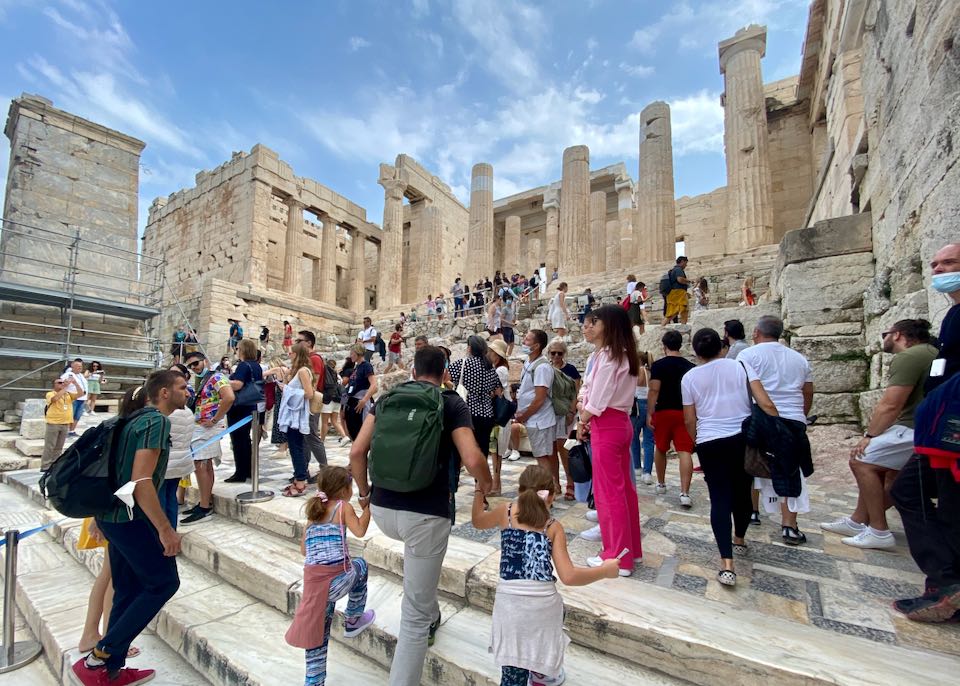

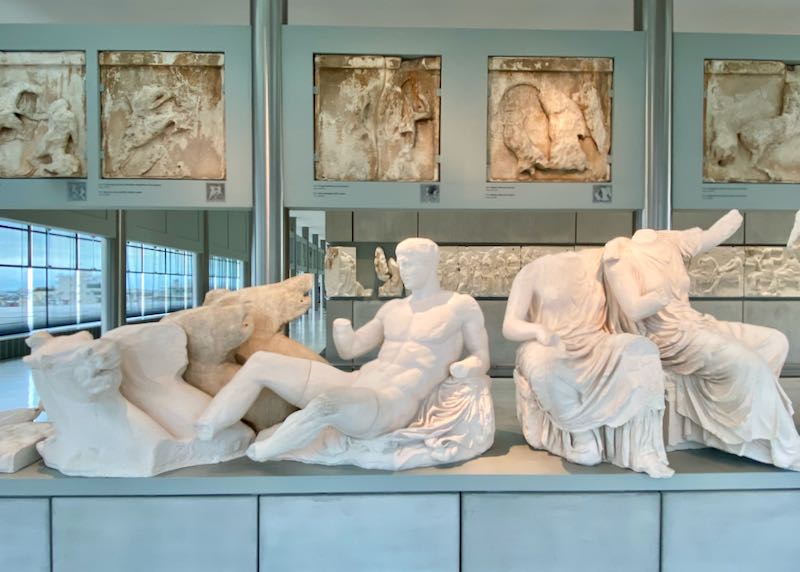

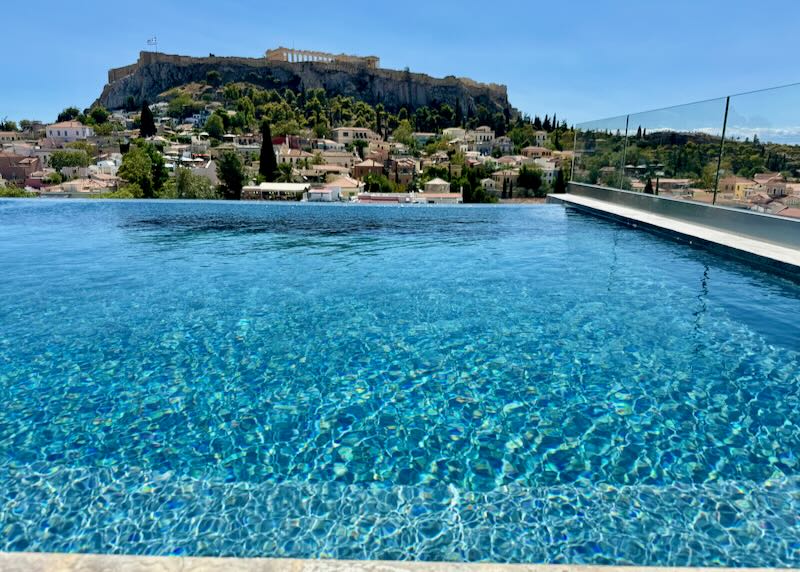
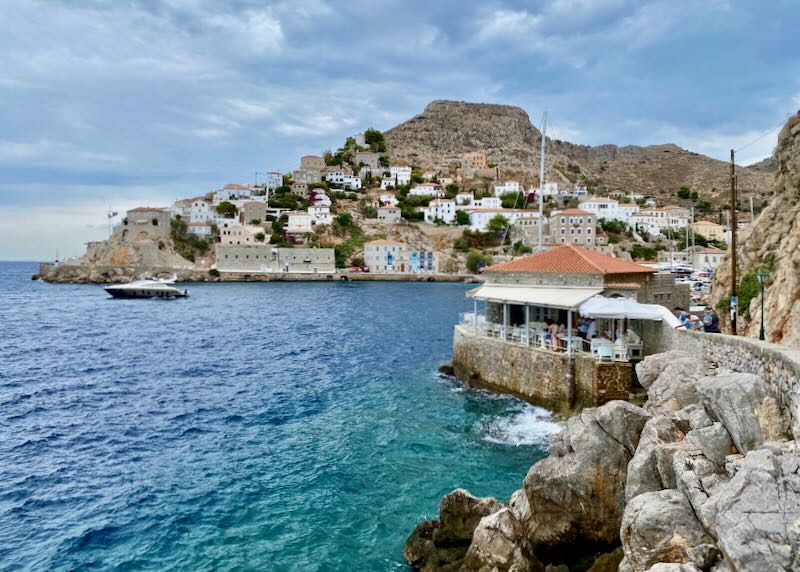
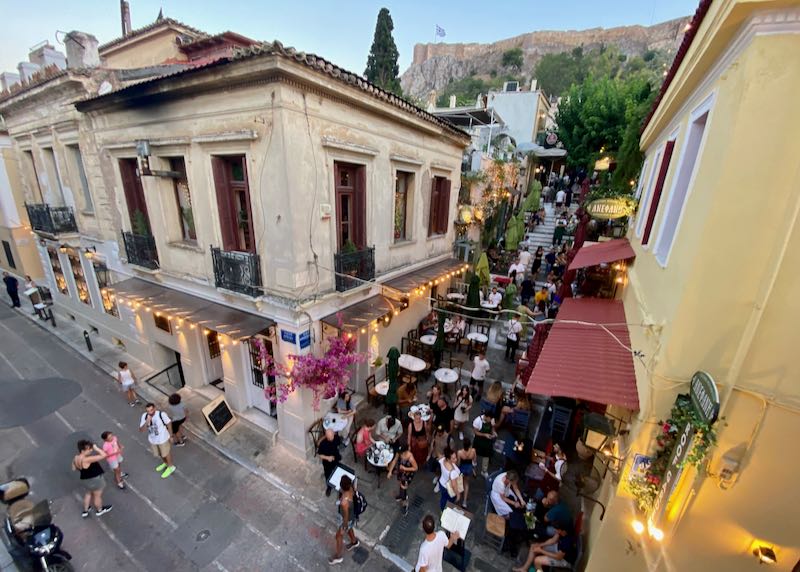

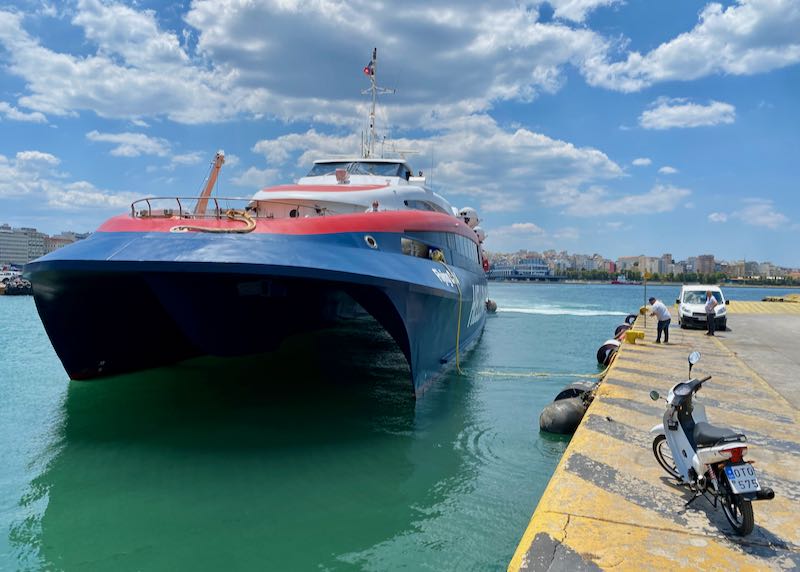


About Santorini Dave